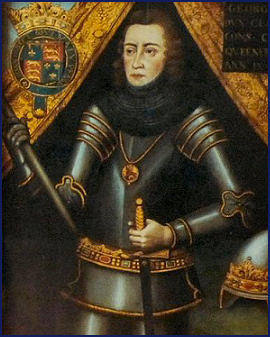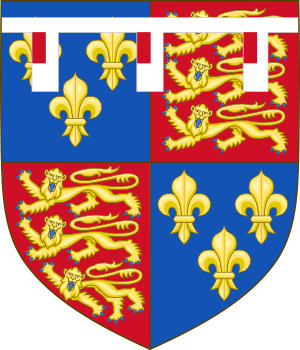George Plantagenet, Duke of Clarence facts for kids
Quick facts for kids George Plantagenet |
|
|---|---|
| Duke of Clarence | |
 |
|
| Born | 21 October 1449 Dublin Castle, Ireland |
| Died | 18 February 1478 (aged 28) Tower of London |
| Burial | 25 February 1478 Tewkesbury Abbey |
| Spouse | |
| Issue more... |
|
| House | York |
| Father | Richard Plantagenet, 3rd Duke of York |
| Mother | Cecily Neville |
George Plantagenet, Duke of Clarence (born October 21, 1449 – died February 18, 1478), was an important figure in English history. He was the sixth son of Richard Plantagenet, 3rd Duke of York, and Cecily Neville. His brothers were Edward IV and Richard III, who both became kings of England.
George lived during a time of big fights between two powerful families, the House of York and the House of Lancaster. These fights are known as the Wars of the Roses. Even though George was part of the York family, he sometimes changed sides. He first supported the Lancasters, but then came back to the Yorkists.
Later, his own brother, King Edward IV, accused him of treason. George was found guilty and executed. He is also a character in plays by William Shakespeare, where his death is shown as part of a plan by his brother Richard.
Contents
Life of George Plantagenet
George was born in Dublin, Ireland, on October 21, 1449. At this time, his father, the Duke of York, was trying to become king instead of Henry VI. George was one of three sons who lived long enough to potentially claim the crown.
In 1461, George's older brother, Edward, became King Edward IV. George was then given the important title of Duke of Clarence. He was also made Lord Lieutenant of Ireland that same year, even though he was still very young.
George was considered a possible husband for Mary of Burgundy, a powerful princess. However, he became very close to his cousin, Richard Neville, Earl of Warwick. Warwick was known as "the Kingmaker" because he had a lot of power to decide who would be king. In July 1469, George married Warwick's older daughter, Isabel Neville, in France.
George had strongly supported his brother Edward's claim to the throne. But when his father-in-law, Warwick, switched his support to the deposed King Henry VI, George followed him. Because of this, George lost his job as Lord Lieutenant. He went to France with Warwick and his pregnant wife. Their first child, a girl, was born on a ship near Calais in April 1470, but she died soon after.
King Henry VI rewarded George for his support by making him next in line to the throne after Henry's own son. This meant Edward IV was no longer considered king. However, George soon realized that Warwick was more interested in his own power than in making George king. Warwick had his younger daughter, Anne Neville, marry Henry VI's son. This showed George that Warwick was not truly working for him. So, George secretly made peace with his brother Edward.
Warwick's efforts to keep Henry VI on the throne failed. Warwick was killed in battle in April 1471. King Edward IV became king again and forgave his brother George. He gave George the important job of Great Chamberlain of England. Since his father-in-law had died, George also became the Earl of Warwick through his wife. However, his younger brother, Richard, Duke of Gloucester, had married Anne Neville, Warwick's other daughter. King Edward divided the family lands between his two brothers.
In 1475, George and Isabel had a son named Edward. Isabel died on December 22, 1476, after giving birth to another son, Richard, who also died young. George and Isabel are buried together at Tewkesbury Abbey. Their surviving children, Margaret and Edward, were looked after by their aunt, Anne Neville.
Death of George Plantagenet
Isabel, George's wife, died in 1476. Many historians believe she died from illness. However, George was convinced that one of her ladies-in-waiting had poisoned her. He accused and had her executed. After this, George's mind became very troubled. This led him to get involved in another rebellion against his brother, King Edward.
In 1477, George wanted to marry Mary of Burgundy, who had just become the Duchess of Burgundy. But King Edward did not approve of this marriage, and George left the royal court.
One of George's servants, an astronomer from Oxford, was arrested. Under pressure, he claimed he had plotted to kill the king using magic. He also named two other men. All three were put on trial for treason. Two of them were executed.
This was a clear warning to George, but he ignored it. He sent a man to Parliament to say that the executed men were innocent. This man had previously supported King Henry VI, which was a bad choice. King Edward was very angry. He accused George of treason and had him arrested.
George was imprisoned in the Tower of London. He was put on trial for treason against his brother, King Edward IV. George was not there for his trial. King Edward himself argued against his brother, asking Parliament to pass a special law to declare George guilty. This law said George was guilty of "unnatural treasons" because he was the king's brother and owed him loyalty. After being found guilty, George was "privately executed" at the Tower of London on February 18, 1478. Tradition says he was drowned in a barrel of Malmsey wine.
One reason Edward might have executed his brother was that George had threatened to question if Edward's marriage was legal. This was a very serious matter at the time.
George in Shakespeare's Plays
George Plantagenet is a main character in two of William Shakespeare's history plays: Henry VI, Part 3 and Richard III. Shakespeare shows George as someone who easily changes his mind. In the plays, he first leaves King Edward IV because he is angry about Edward's marriage. Even after saying he would be loyal to Warwick and Henry VI, George quickly returns to Edward's side when he sees his brothers again.
George's Children
George married Isabel Neville in Calais, England, on July 11, 1469. They had four children together:
- Anne of Clarence (born April 16, 1470 – died around April 17, 1470). She was born and died on a ship near Calais.
- Margaret Pole, Countess of Salisbury (born August 14, 1473 – died May 28, 1541). She married Sir Richard Pole and was later executed by King Henry VIII.
- Edward Plantagenet, 17th Earl of Warwick (born February 25, 1475 – died November 28, 1499). He was the last direct male heir of the Plantagenet family. He was executed by King Henry VII after being accused of trying to escape from the Tower of London.
- Richard of Clarence (born October 5, 1476 – died January 1, 1477). He was born at Tewkesbury Abbey and died at Warwick Castle.
Family Tree
| English royal families in the Wars of the Roses | |||||||||||||||||||||||||||||||||||||||||||||||||||||||||||||||||||||||||||||||||||||||||||||||||||||||||||||||||||||||||||||||||||||||||||||||||||||||||||||||||||||||||||||||||||||||||||||||||||||||||||||||||||||||||||||||||||||||||||||||||||||||||||||||||||||||||||||||||||||||||||||||||||||||||||||||||||||||||||||||||||||||||||||||||||||||||||||||||||||||||||||||||||||||||||||||||||||||||||||||||||||||||||||||||||||||||||||||||||||||||||||||||||||||||||||||||||||||||||||||||||||||||||||||||||||||||||||||||||||||||||||||||||||||||||||||||||||||||||||||||||||||||||||||||||||||||||||||||||||||||||||||||||||||||||||||||||||||||||||||||||||||||||||||||||||||||||||||||||||||||||||||||||||||||||||||||||||||||||||||||||||||||||||||||||||||||||||||||||||||||||||||||||||||||||||||||||||||||||||||||||||||||||||||||||||||||||||||||||||||||||||||||||||||||||||||||||||||||||||||||||||||||||||||||||||||||||||||||||||||||||||||||||||||||||||||||||||||||||||||||||||||||||||||||||||||||||||||||||||||
|---|---|---|---|---|---|---|---|---|---|---|---|---|---|---|---|---|---|---|---|---|---|---|---|---|---|---|---|---|---|---|---|---|---|---|---|---|---|---|---|---|---|---|---|---|---|---|---|---|---|---|---|---|---|---|---|---|---|---|---|---|---|---|---|---|---|---|---|---|---|---|---|---|---|---|---|---|---|---|---|---|---|---|---|---|---|---|---|---|---|---|---|---|---|---|---|---|---|---|---|---|---|---|---|---|---|---|---|---|---|---|---|---|---|---|---|---|---|---|---|---|---|---|---|---|---|---|---|---|---|---|---|---|---|---|---|---|---|---|---|---|---|---|---|---|---|---|---|---|---|---|---|---|---|---|---|---|---|---|---|---|---|---|---|---|---|---|---|---|---|---|---|---|---|---|---|---|---|---|---|---|---|---|---|---|---|---|---|---|---|---|---|---|---|---|---|---|---|---|---|---|---|---|---|---|---|---|---|---|---|---|---|---|---|---|---|---|---|---|---|---|---|---|---|---|---|---|---|---|---|---|---|---|---|---|---|---|---|---|---|---|---|---|---|---|---|---|---|---|---|---|---|---|---|---|---|---|---|---|---|---|---|---|---|---|---|---|---|---|---|---|---|---|---|---|---|---|---|---|---|---|---|---|---|---|---|---|---|---|---|---|---|---|---|---|---|---|---|---|---|---|---|---|---|---|---|---|---|---|---|---|---|---|---|---|---|---|---|---|---|---|---|---|---|---|---|---|---|---|---|---|---|---|---|---|---|---|---|---|---|---|---|---|---|---|---|---|---|---|---|---|---|---|---|---|---|---|---|---|---|---|---|---|---|---|---|---|---|---|---|---|---|---|---|---|---|---|---|---|---|---|---|---|---|---|---|---|---|---|---|---|---|---|---|---|---|---|---|---|---|---|---|---|---|---|---|---|---|---|---|---|---|---|---|---|---|---|---|---|---|---|---|---|---|---|---|---|---|---|---|---|---|---|---|---|---|---|---|---|---|---|---|---|---|---|---|---|---|---|---|---|---|---|---|---|---|---|---|---|---|---|---|---|---|---|---|---|---|---|---|---|---|---|---|---|---|---|---|---|---|---|---|---|---|---|---|---|---|---|---|---|---|---|---|---|---|---|---|---|---|---|---|---|---|---|---|---|---|---|---|---|---|---|---|---|---|---|---|---|---|---|---|---|---|---|---|---|---|---|---|---|---|---|---|---|---|---|---|---|---|---|---|---|---|---|---|---|---|---|---|---|---|---|---|---|---|---|---|---|---|---|---|---|---|---|---|---|---|---|---|---|---|---|---|---|---|---|---|---|---|---|---|---|---|---|---|---|---|---|---|---|---|---|---|---|---|---|---|---|---|---|---|---|---|---|---|---|---|---|---|---|---|---|---|---|---|---|---|---|---|---|---|---|---|---|---|---|---|---|---|---|---|---|---|---|---|---|---|---|---|---|---|---|---|---|---|---|---|---|---|---|---|---|---|---|---|---|---|---|---|---|---|---|---|---|---|---|---|---|---|---|---|---|---|---|---|---|---|---|---|---|---|---|---|---|---|---|---|---|---|---|---|---|---|---|---|---|---|---|---|---|---|---|---|---|---|---|---|---|---|---|---|---|---|---|---|---|---|---|---|---|---|---|---|---|---|---|---|---|---|---|---|---|---|---|---|---|---|---|---|---|---|---|---|---|---|---|---|---|---|---|---|---|---|---|---|---|---|---|---|---|---|---|---|---|---|---|---|---|---|---|---|---|---|---|---|---|---|---|---|---|---|---|---|---|---|---|---|---|---|---|---|---|---|---|---|---|---|---|---|---|---|---|---|---|---|---|---|---|---|---|---|---|---|---|---|---|---|---|---|---|---|---|---|---|---|---|---|---|---|---|---|---|---|---|---|---|---|---|---|---|---|---|---|---|---|---|---|---|---|---|---|---|---|---|---|---|---|---|---|---|---|---|---|---|---|---|---|---|---|---|---|---|---|---|---|---|---|---|---|---|---|---|---|---|---|---|---|---|---|---|---|---|---|---|---|---|---|---|---|---|---|---|---|---|---|---|---|---|---|---|---|---|---|---|---|---|---|---|---|---|---|---|---|---|---|---|---|---|---|---|---|---|---|---|---|---|---|---|---|---|---|---|---|---|---|---|---|---|---|---|---|---|---|---|---|---|---|---|---|---|---|---|---|---|---|---|---|---|---|---|---|---|---|---|---|---|---|---|---|---|---|---|---|---|---|---|---|---|---|---|---|---|---|---|---|---|---|---|---|
|
Individuals with red dashed borders are Lancastrians and blue dotted borders are Yorkists. Some changed sides and are represented with a solid thin purple border. Monarchs have a rounded-corner border.
|
|||||||||||||||||||||||||||||||||||||||||||||||||||||||||||||||||||||||||||||||||||||||||||||||||||||||||||||||||||||||||||||||||||||||||||||||||||||||||||||||||||||||||||||||||||||||||||||||||||||||||||||||||||||||||||||||||||||||||||||||||||||||||||||||||||||||||||||||||||||||||||||||||||||||||||||||||||||||||||||||||||||||||||||||||||||||||||||||||||||||||||||||||||||||||||||||||||||||||||||||||||||||||||||||||||||||||||||||||||||||||||||||||||||||||||||||||||||||||||||||||||||||||||||||||||||||||||||||||||||||||||||||||||||||||||||||||||||||||||||||||||||||||||||||||||||||||||||||||||||||||||||||||||||||||||||||||||||||||||||||||||||||||||||||||||||||||||||||||||||||||||||||||||||||||||||||||||||||||||||||||||||||||||||||||||||||||||||||||||||||||||||||||||||||||||||||||||||||||||||||||||||||||||||||||||||||||||||||||||||||||||||||||||||||||||||||||||||||||||||||||||||||||||||||||||||||||||||||||||||||||||||||||||||||||||||||||||||||||||||||||||||||||||||||||||||||||||||||||||||||
Images for kids
-
The Duke and Duchess of Clarence, Cardiff Castle.
See also
 In Spanish: Jorge de Clarence para niños
In Spanish: Jorge de Clarence para niños



